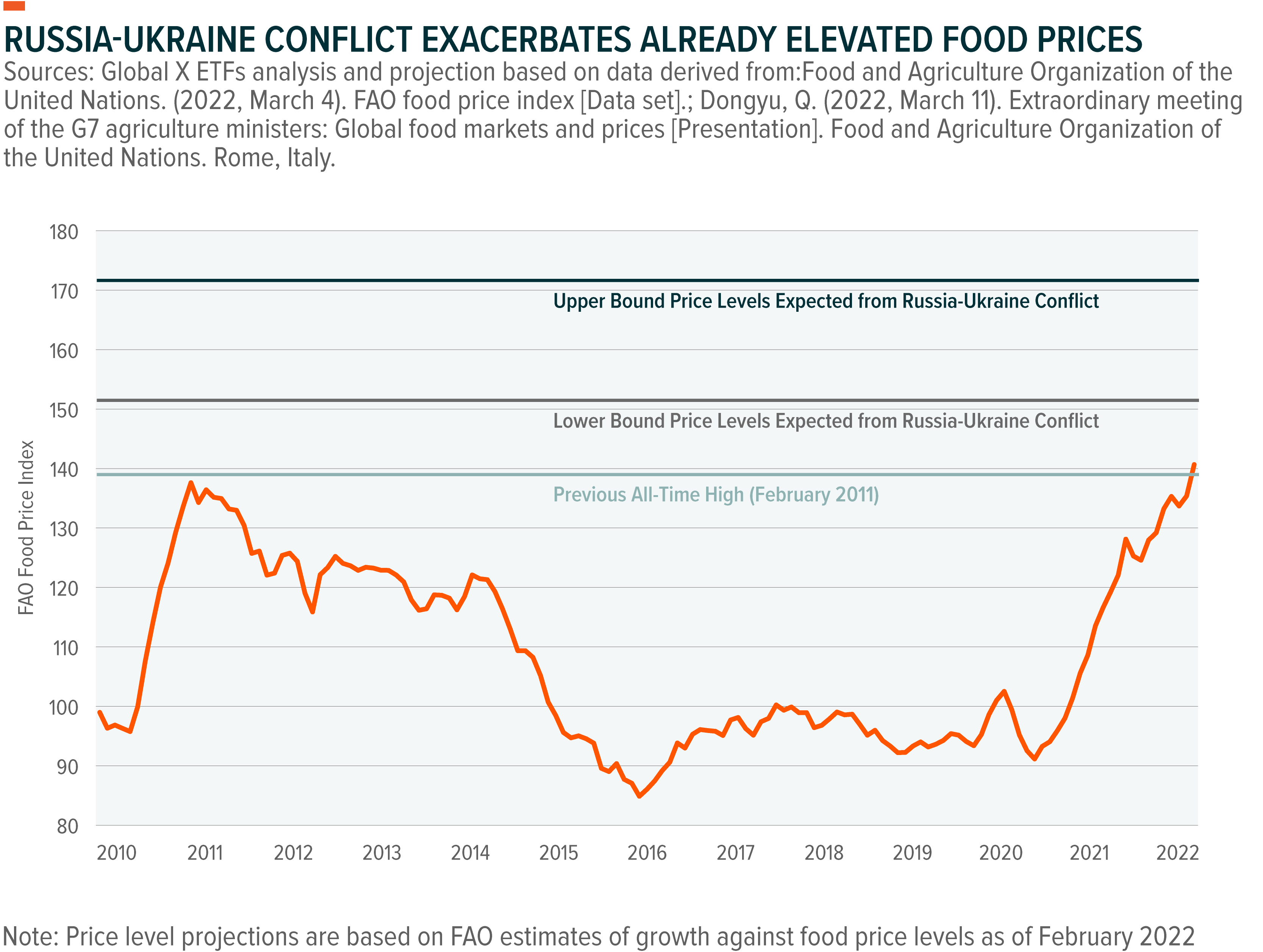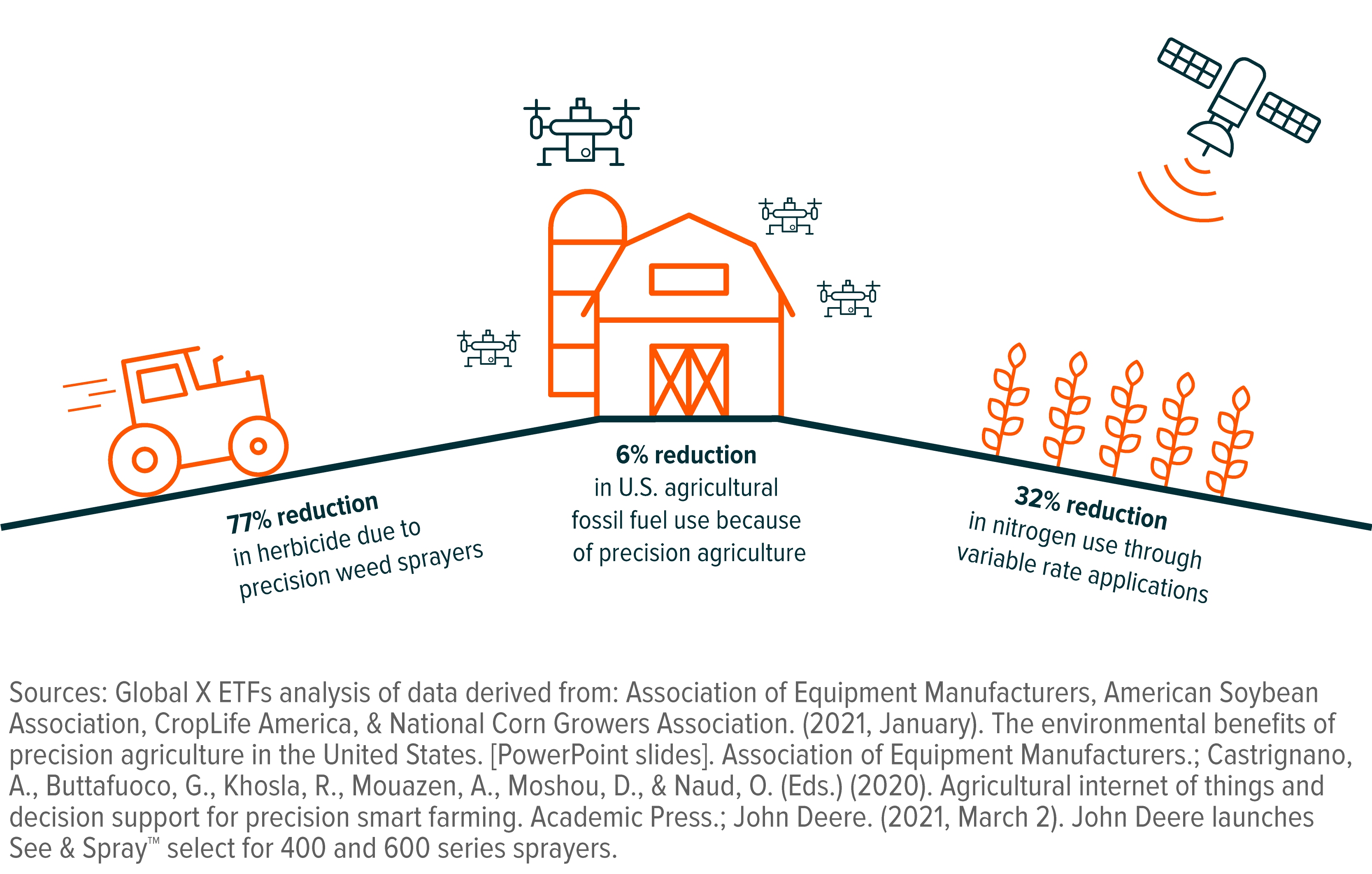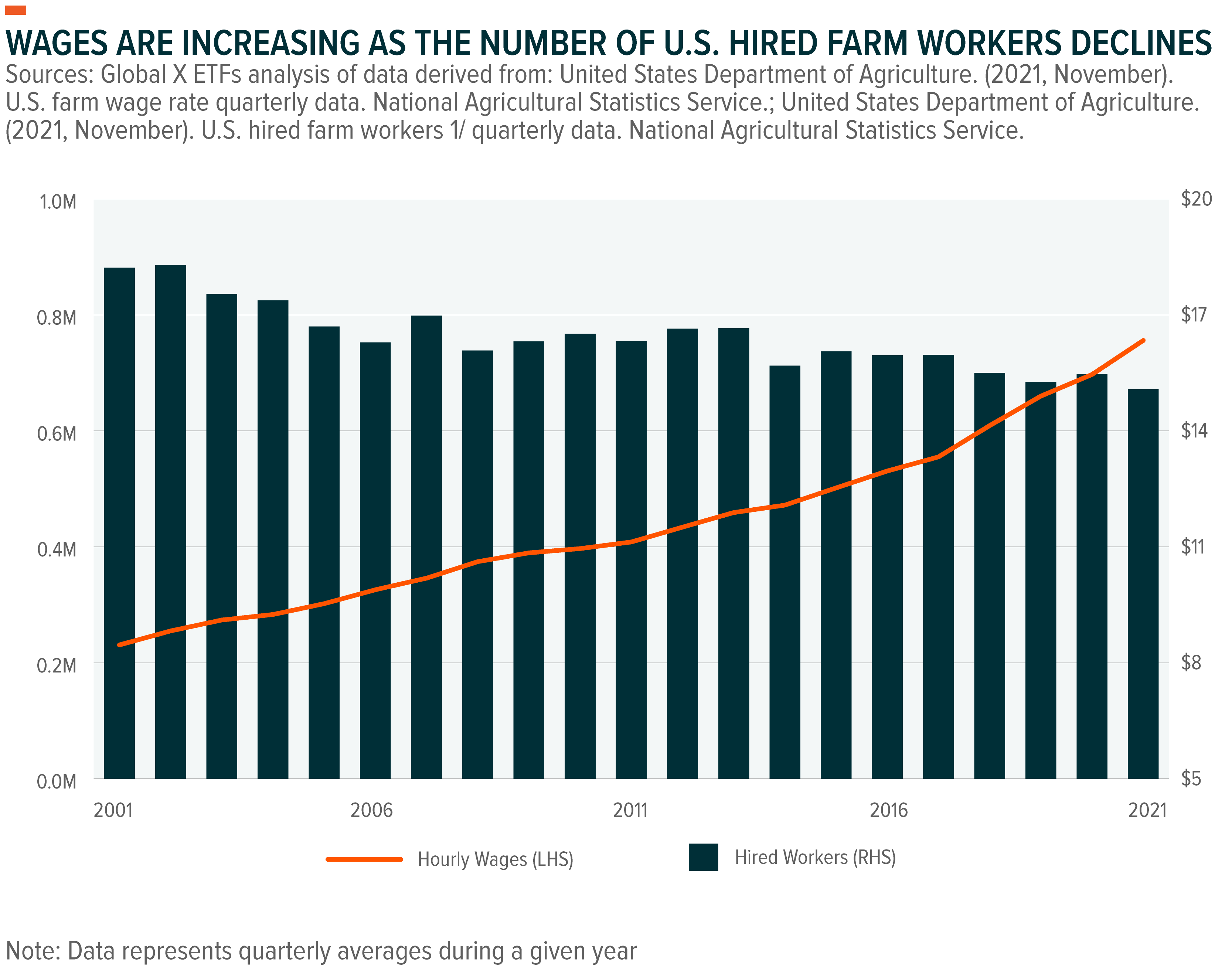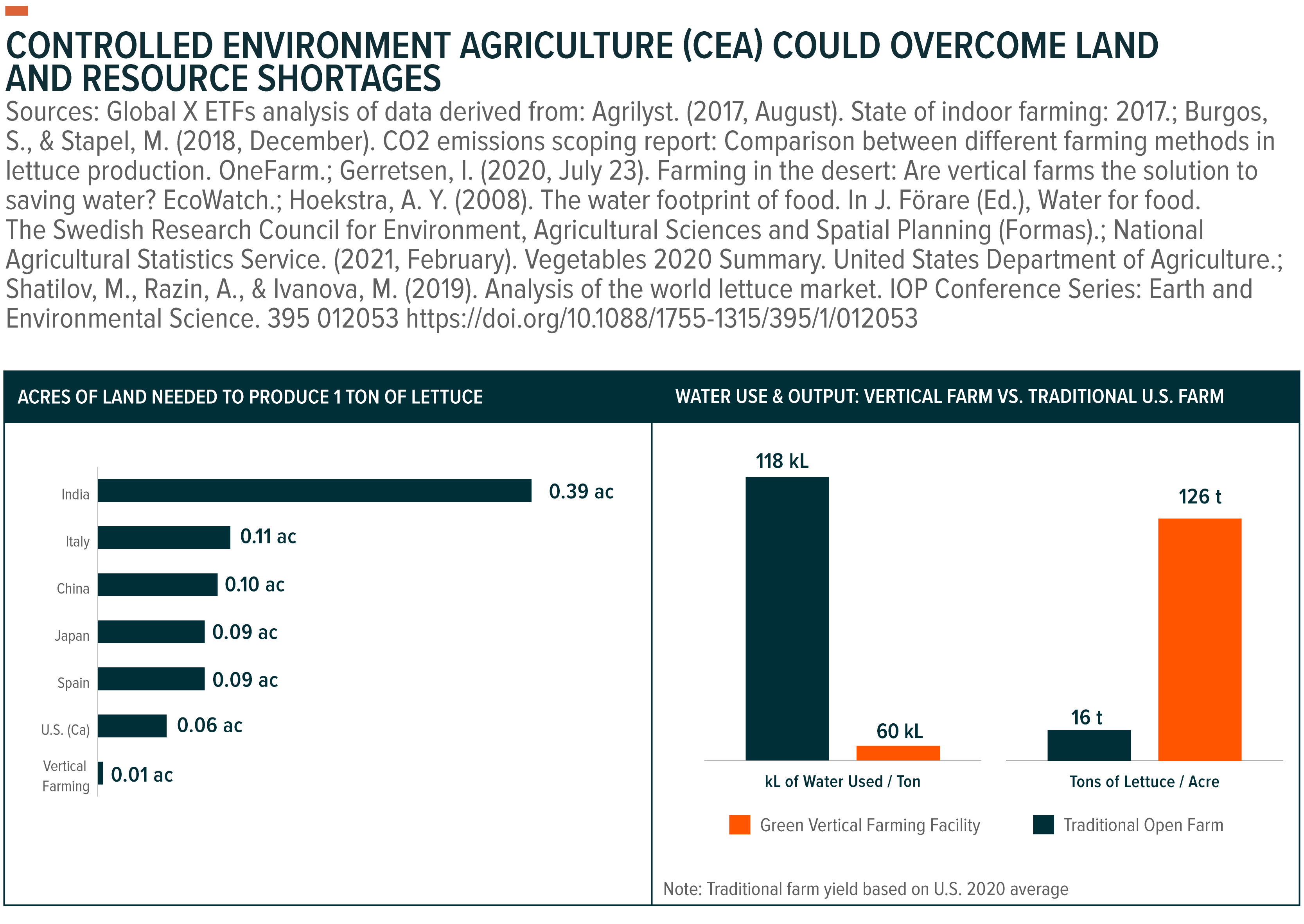Food systems are struggling to contend with mounting threats presented by the pandemic, unfavorable commodity pricing, warfare, labor shortages, and worsening climatic conditions. As a result of these compounding factors, food prices are high and food availability is declining. According to the Food and Agriculture Organization (FAO), international food prices reached an all-time high in February 2022, and the number of people facing food insecurity globally increased by an estimated 32% in 2021.1,2 Recent events not only expose current vulnerabilities in agricultural supply chains but also reveal how long-term trends could render the world unprepared to feed future populations. In this piece, we discuss current vulnerabilities in global food systems and explain how existing agricultural technology (AgTech) could help secure the world’s future food supply.
Key Takeaways
- The Ukraine-Russia conflict has resulted in an unprecedented agricultural commodity environment that is likely to contribute to food insecurity.
- Even before the invasion, pandemic-rattled supply chains and unfavorable structural trends lifted food prices to all-time highs.
- AgTech such as precision agriculture, agricultural robots, and controlled environment agriculture could optimize agricultural production, countering current and future challenges.
Russia-Ukraine Conflict Disrupts a Global Breadbasket
Together, Russia and Ukraine account for significant portions of global agricultural exports, including about 30% of the wheat trade.3 The United States Department of Agriculture (USDA) forecasts the war to cut Russian and Ukrainian wheat exports by 12%.4 Lower exports will translate into higher food prices in the United States, but for other countries the impact could be much more dire. About 50 countries rely on Russia and Ukraine for at least 30% of their wheat imports, and 26 of these countries depend on them for over half of their wheat supplies.5 Warfare is also likely to disrupt global trade of sunflower oil, maize, and barley, as well as supplies for agricultural inputs.
Russia is the largest exporter of nitrogen-based fertilizer and a top producer of most other nutrient types, including potassium and phosphorous.6 In response to sanctions, the Russian government suspended fertilizer exports, a move that exacerbates pre-existing shortages.7 As a result, farmers worldwide are scrambling to secure adequate supplies of nutrients before the spring planting season. The fertilizer scarcity prompted the USDA to create a new $250 million grant program that supports domestic fertilizer production, set to begin this summer.8
Rising oil and gas prices also affect agricultural margins. Prices for diesel fuel, which farmers rely on to run heavy-duty equipment, have increased about 25% in the United States since the invasion began.9 Additionally, high natural gas prices contribute to concerns of increasing fertilizer prices. Natural gas prices account for 75–90% of total costs associated with nitrogen fertilizer, so elevated commodity pricing directly translates into more expensive fertilizer.10 All together the Russia-Ukraine conflict could cause food prices to rise 8%–22%, leading to food insecurity for tens of millions more people.11

Food Systems Were Already Vulnerable Before the War
Supply chain disruptions, increasing input costs, and varied worker availability have tormented food producers over the last two years. Unfortunately, consumers bear the brunt of these pandemic-related effects. Higher prices and limited supplies have doubled global food insecurity since 2020.12 In the United States, food insecurity affects 15% of the population, up from 11% before the pandemic.13,14
Current labor shortages are often associated with the pandemic; however, they are also part of a secular trend. A June 2021 survey from Purdue University found that 66% of respondents reported difficulty finding workers to fill agricultural jobs, more than double the rate found in a comparable June 2020 survey.15 Additionally, according to the National Agriculture Statistical Service and the USDA, the number of self-employed farmworkers in the United States declined 73% from 1950 to 2000 while hired hands declined 52%.16 In more recent years, workers find higher-paying and less labor-intensive opportunities, leaving farms chronically shorthanded.17
The effects of extreme weather spurred by climate change on crop yields reflects another challenge for food production. In 2021, drought and extreme heat resulted in a 10% decline in wheat production in the United States and a 33% decline in average yield per acre of barley.18,19 Climate experts estimate that the ongoing drought in the western United States marks the worst in 1,200 years and attribute roughly 42% of the severity to climate change.20 Elsewhere, unusual precipitation and flooding in China created possibly the worst winter crop conditions on record and frost earlier in the year damaged Brazilian coffee yields.21,22 The destruction caused by natural disasters and the increasing variability in weather conditions appears likely to multiply in the coming decades as climate change impacts become more pronounced.23
AgTech Adoption Could Help Alleviate Food Production Pressures
AgTech strategies seek to improve agricultural production by minimizing inputs and maximizing outputs. Wider adoption of precision agriculture, agricultural robots, and controlled environment agriculture could alleviate some of the pressures created by long- and short-term trends.
Precision Agriculture: Technologies that increase crop yields while reducing the use of traditional agricultural inputs, such as fertilizer, herbicide, and water. Many of these techniques involve satellite imagery, Internet of Things (IoT) sensor monitoring, artificial intelligence (AI), and/or geographic information system (GIS) software.
An example of precision agriculture, Variable Rate Applications (VRA) involves a technique that caters resource usage to the specific characteristics of a piece of land. IoT sensors record and transmit data on factors such as crop health, soil properties, and nutrient levels to determine how many resources are needed for a given segment of the farm. AI-driven software then pair this data with geographic information derived from satellite imagery or drones and provide instructions to farmers. This process potentially prevents farmers from wasting resources on healthy crops, of particular use in markets where inputs remain scarce and expensive.
To this end, VRA potentially reduces fertilizer use by more than 30%.24 Adoption of precision agriculture in the United States has improved fertilizer placement efficiency by an estimated 7%, and further adoption could lead to an additional 14% improvement.25 Precision agriculture also serves as an option to conserve water, herbicide, fuel, and other inputs.

Agricultural Robots (AgRobots): Autonomous technologies that help reduce farming inputs, such as labor. Examples of this technology include farming drones, automatic irrigation, and autonomous tractors.
Besides synergizing with precision agriculture and improving yields, AgRobots could assist with agricultural labor shortages. The U.S. Bureau of Labor Statistics estimates that total employment of farmers, ranchers, and other agricultural managers will decline 1% between 2020 and 2030, with an average of 84,000 job openings each year.26 Many farmers are expected to leave the workforce due to age or better opportunities, just as food production should accelerate.
The FAO estimates that the world needs to increase food production by 50% by 2050 due to population growth.27 Fortunately, technologies currently in development could transform farming into a more tech-heavy process rather than a labor-intensive one. Some farmers already use machines, such as drones, to administer agricultural inputs or autonomous crop pickers to increase productivity.28
AgRobots are also hitting the mainstream. Major equipment provider Deere recently announced that it plans to bring an autonomous tractor, controllable via a smart phone app, to market later in 2022.29 With up to 410 horsepower, this machine is designed to take on heavy-duty agricultural tasks, such as planting and tilling.30 Additional AgRobot product offerings from prominent equipment manufacturers could help normalize autonomous farming while addressing labor shortages.

Controlled Environment Agriculture (CEA): The use of modified indoor environments to optimize agricultural production. These techniques include, but are not limited to, vertical farming, greenhouses, hydroponics, aquaponics, and aeroponics.
CEA enclosures often remain protected from the elements and lack the same exposure to the irregular or severe weather patterns associated with climate change as traditional farms. CEA techniques also address climate change outcomes such as land degradation and water shortages. Overall, modified environments expand the useful area that can be used for agriculture, require a fraction of the land to produce the same output as traditional farms, and in the case of vertical farms, use 95% less water.31
In its latest report, the Intergovernmental Panel on Climate Change (IPCC) identifies urban agriculture and vertical farming as possible adaption strategies for climate change.32 Additionally, because of land efficiency, CEAs can be positioned closer to population centers than traditional farms. Proximity to densely populated areas helps cut down on fossil fuel use in food transportation and less time in transit creates less spoilage.

Conclusion
Vulnerabilities are already evident in global food systems, and the Russia-Ukraine conflict presents even more challenges. However, AgTech can help stave off long-term food insecurity and counter geopolitical consequences. Further adoption of AgTech could facilitate more intelligent decisions about how to protect the world’s dwindling resources, which ultimately could mean feeding millions more people.
Related ETFs
KROP: The Global X AgTech & Food Innovation ETF seeks to invest in companies advancing innovation and the use of technology in the agriculture and food industries. This includes companies involved in the provision of agricultural technologies (“AgTech”) related to precision agriculture, agricultural robots and automation, controlled environment agriculture (e.g., vertical farming, hydroponics), and agricultural biotechnology, as well as those involved in food innovation activities related to protein/dairy alternatives and food waste reduction.
Click the fund name above to view current holdings. Holdings are subject to change. Current and future holdings are subject to risk.
 Madeline Ruid
Madeline Ruid